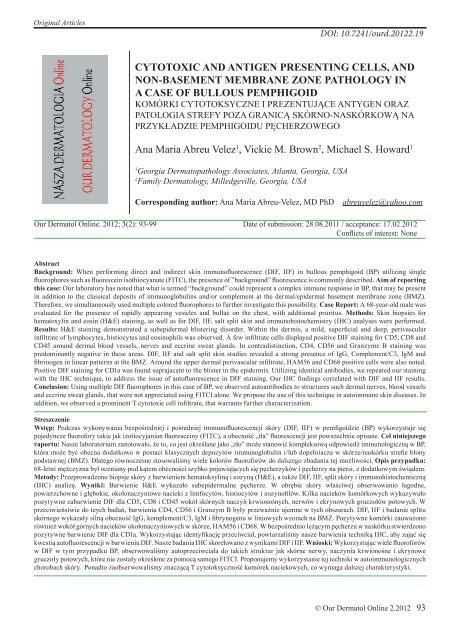download full issue - Our Dermatology Online Journal
download full issue - Our Dermatology Online Journal
download full issue - Our Dermatology Online Journal
You also want an ePaper? Increase the reach of your titles
YUMPU automatically turns print PDFs into web optimized ePapers that Google loves.
Original Articles<br />
DOI: 10.7241/ourd.20122.19<br />
CYTOTOXIC AND ANTIGEN PRESENTING CELLS, AND<br />
NON-BASEMENT MEMBRANE ZONE PATHOLOGY IN<br />
A CASE OF BULLOUS PEMPHIGOID<br />
KOMÓRKI CYTOTOKSYCZNE I PREZENTUJĄCE ANTYGEN ORAZ<br />
PATOLOGIA STREFY POZA GRANICĄ SKÓRNO-NASKÓRKOWĄ NA<br />
PRZYKŁADZIE PEMPHIGOIDU PĘCHERZOWEGO<br />
Ana Maria Abreu Velez 1 , Vickie M. Brown 2 , Michael S. Howard 1<br />
1<br />
Georgia Dermatopathology Associates, Atlanta, Georgia, USA<br />
2<br />
Family <strong>Dermatology</strong>, Milledgeville, Georgia, USA<br />
Corresponding author: Ana Maria Abreu-Velez, MD PhD abreuvelez@yahoo.com<br />
<strong>Our</strong> Dermatol <strong>Online</strong>. 2012; 3(2): 93-99 Date of submission: 28.08.2011 / acceptance: 17.02.2012<br />
Conflicts of interest: None<br />
Abstract<br />
Background: When performing direct and indirect skin immunofluorescence (DIF, IIF) in bullous pemphigoid (BP) utilizing single<br />
fluorophores such as fluorescein isothiocyanate (FITC), the presence of ”background” fluorescence is commonly described. Aim of reporting<br />
this case: <strong>Our</strong> laboratory has noted that what is termed “background” could represent a complex immune response in BP, that may be present<br />
in addition to the classical deposits of immunoglobulins and/or complement at the dermal/epidermal basement membrane zone (BMZ).<br />
Therefore, we simultaneously used multiple colored fluorophores to further investigate this possibility. Case Report: A 68-year-old male was<br />
evaluated for the presence of rapidly appearing vesicles and bullae on the chest, with additional pruritus. Methods: Skin biopsies for<br />
hematoxylin and eosin (H&E) staining, as well as for DIF, IIF, salt split skin and immunohistochemistry (IHC) analyses were performed.<br />
Results: H&E staining demonstrated a subepidermal blistering disorder. Within the dermis, a mild, superficial and deep, perivascular<br />
infiltrate of lymphocytes, histiocytes and eosinophils was observed. A few infiltrate cells displayed positive DIF staining for CD5, CD8 and<br />
CD45 around dermal blood vessels, nerves and eccrine sweat glands. In contradistinction, CD4, CD56 and Granzyme B staining was<br />
predominantly negative in these areas. DIF, IIF and salt split skin studies revealed a strong presence of IgG, Complement/C3, IgM and<br />
fibrinogen in linear patterns at the BMZ. Around the upper dermal perivascular infiltrate, HAM56 and CD68 positive cells were also noted.<br />
Positive DIF staining for CD1a was found suprajacent to the blister in the epidermis. Utilizing identical antibodies, we repeated our staining<br />
with the IHC technique, to address the <strong>issue</strong> of autofluorescence in DIF staining. <strong>Our</strong> IHC findings correlated with DIF and IIF results.<br />
Conclusion: Using multiple DIF fluorophores in this case of BP, we observed autoantibodies to structures such dermal nerves, blood vessels<br />
and eccrine sweat glands, that were not appreciated using FITCI alone. We propose the use of this technique in autoimmune skin diseases. In<br />
addition, we observed a prominent T cytotoxic cell infiltrate, that warrants further characterization.<br />
Streszczenie<br />
Wstęp: Podczas wykonywania bezpośredniej i pośredniej immunofluorescencji skóry (DIF, IIF) w pemfigoidzie (BP) wykorzystuje się<br />
pojedyncze fluorofory takie jak izotiocyjanian fluoresceiny (FITC), a obecność „tła” fluorescencji jest powszechnie opisane. Cel niniejszego<br />
raportu: Nasze laboratorium zanotowało, że to, co jest określane jako „tło” może stanowić kompleksową odpowiedź immunologiczną w BP,<br />
która może być obecna dodatkowo w postaci klasycznych depozytów immunoglobulin i/lub dopełniacza w skórze/naskórku strefie błony<br />
podstawnej (BMZ). Dlatego równoczesne stosowaliśmy wiele kolorów fluoroforów do dalszego zbadania tej możliwości. Opis przypadku:<br />
68-letni mężczyzna był oceniany pod kątem obecności szybko pojawiających się pęcherzyków i pęcherzy na piersi, z dodatkowym świądem.<br />
Metody: Przeprowadzono biopsje skóry z barwieniem hematoksyliną i eozyną (H&E), a także DIF, IIF, split skóry i immunohistochemiczną<br />
(IHC) analizę. Wyniki: Barwienie H&E wykazało subepidermalne pęcherze. W obrębie skóry właściwej obserwowanio łagodne,<br />
powierzchowne i głębokie, okołonaczyniowe nacieki z limfocytów, histiocytów i eozynofilów. Kilka nacieków komórkowych wykazywało<br />
pozytywne zabarwienie DIF dla CD5, CD8 i CD45 wokół skórnych naczyń krwionośnych, nerwów i ekrynowych gruczołów potowych. W<br />
przeciwieństwie do teych badań, barwienia CD4, CD56 i Granzym B były przeważnie ujemne w tych obszarach. DIF, IIF i badanie splitu<br />
skórnego wykazały silną obecność IgG, komplement/C3, IgM i fibrynogenu w liniowych wzorach na BMZ. Pozytywne komórki zauważono<br />
również wokół górnych nacieków okołonaczyniowych w skórze, HAM56 i CD68. W bezpośrednio leżącym pęcherzu w naskórku stwierdzono<br />
pozytywne barwienie DIF dla CD1a. Wykorzystując identyfikację przeciwciał, powtarzaliśmy nasze barwienia techniką IHC, aby zająć się<br />
kwestią autofluorescencji w barwieniu DIF. Nasze badania IHC skorelowano z wynikami DIF i IIF. Wnioski: Wykorzystując wiele fluoroforów<br />
w DIF w tym przypadku BP, obserwowaliśmy autoprzeciwciała do takich struktur jak skórne nerwy, naczynia krwionośne i ekrynowe<br />
gruczoły potowych, które nie zostały określone za pomocą samego FITCI. Proponujemy wykorzystanie tej techniki w autoimmunologicznych<br />
chorobach skóry. Ponadto zaobserwowaliśmy znaczącą T cytotoksyczność komórek naciekowych, co wymaga dalszej charakterystyki.<br />
© <strong>Our</strong> Dermatol <strong>Online</strong> 2.2012 93















